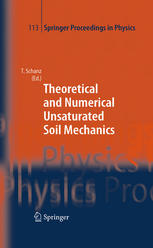Theoretical and Numerical Unsaturated Soil Mechanics

Foreword
The event is a continuation of the series of International Conferences on Unsaturated
Soils in Germany. The first International Conference was held during
September 2003 in Bauhaus-University Weimar, Weimar, Germany. The
current event is the second one in the series entitled “Mechanics of Unsaturated
Soils.” The primary objective of the Conference has been to discuss
and understand unsaturated soil behaviour such that engineered activities are
made better with times in terms of judgement and quality. We all realise by
now that in addition to the knowledge on the classical concepts, it becomes
an enormous challenging task to adapt convincing new concepts and present
them in such a way that it could be used in engineering practices. During
the last six years or so (2001–2007), scientific research works were extensively
taken up by five scientific research teams from five German universities,
whose scientific leaders are Wolfgang Ehlers (Universität Stuttgart), Jens Engel
(HTW Dresden), Rainer Helmig and Holger Claas (Universität Stuttgart),
Tom Schanz (Bauhaus Universität Weimar), Christos Vrettos, Helmut Meissner
and Andreas Becker (Universität Kaiserslautern). The research studies
involved theoretical and numerical approaches along with experimental studies
on unsaturated soils. These two volumes present recent research findings
obtained within this collaboration by the above research groups along with
excellent contributions from several research groups throughout the World.
The experimental studies reported herein primarily focussed on the role
of microstructure and fabric for the complex coupled hydro-mechanical behaviour
of cohesive frictional materials. Several papers considered the relevance
of temperature affecting the constitutive behaviour of clays. A careful
reader may recognise that in both the topics there is an ambiguity with regard
to the conclusions derived. Common features of state of the art theoretical
and numerical approaches, including TPM (theory of porous media) and
mixture theory, intend to describe the complex multi-field problems of fully
coupled thermo-hydraulic-mechanical-chemical initial-boundary value problems.
Additional important field of research includes optimization of numerical
schemes to gain better computational performance. Applications include
Download
http://s18.alxa.net/s18/srvs2/01/The....Mechanics.rar